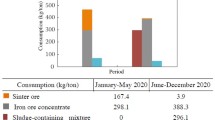Abstract
Improving the quality of the iron-ore-based materials used in blast-furnace smelting is an effective means of reducing coke consumption and improving the other technical-economic indices that characterize the production of pig iron. One important factor in solving this problem is narrowing the range of fluctuation of the iron content and basicity of the sinter. The chemical composition of sinter can be stabilized by carefully averaging the iron ores used to make the sinter. However, since such averaging is precluded by the limited storage space available at the sinter plant of ISPAT-Karmet, the combine has developed a technology to make sinter of stable chemical composition. The key elements of the technology: obtaining representative samples of the materials; forming piles of mixtures of ores; calculating the chemical composition of the planned piles; determining consumption factors for the components of the charge, in order to obtain sinter of the prescribed chemical composition; using an express method to determine the losses incurred during sintering; statistically analyzing the quality of the charge components and the sinter. The use of this technology for multicomponent charges in the sinter shop at ISPAT-Karmet has appreciably stabilized the chemical composition of the sinter – the standard deviation is now 0.295–0.311% for iron content and 0.031–0.037 for basicity.
Similar content being viewed by others
Author information
Authors and Affiliations
Rights and permissions
About this article
Cite this article
Vikulov, G.S., Vilkov, A.E., Kabanov, Y.A. et al. Production of Sinter of a Prescribed Chemical Composition. Metallurgist 46, 174–177 (2002). https://doi.org/10.1023/A:1020484920155
Issue Date:
DOI: https://doi.org/10.1023/A:1020484920155




